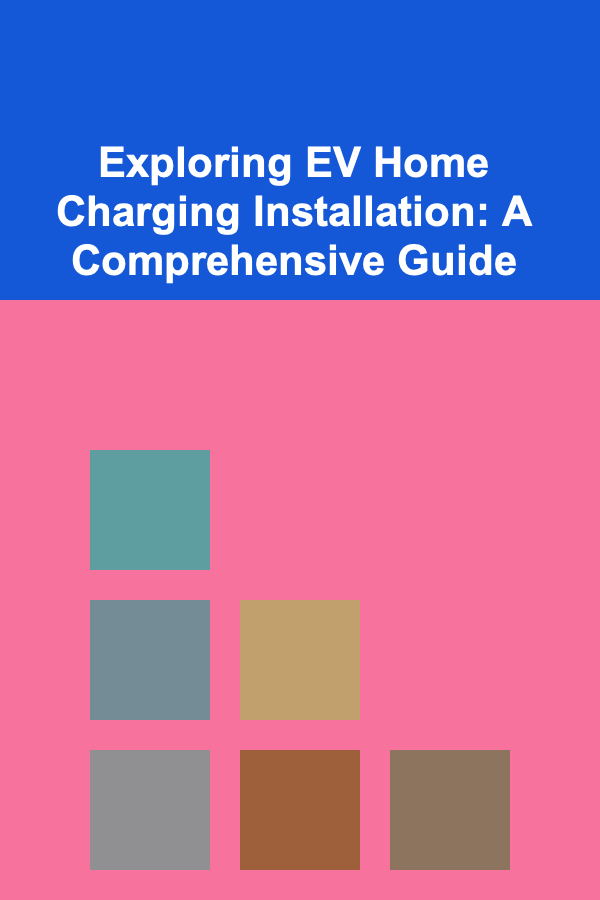
Exploring EV Home Charging Installation: A Comprehensive Guide
ebook include PDF & Audio bundle (Micro Guide)
$12.99$8.99
Limited Time Offer! Order within the next:

The transition to electric vehicles (EVs) is rapidly accelerating, driven by environmental concerns, government incentives, and advancements in battery technology. As EV ownership becomes more commonplace, the need for convenient and efficient charging solutions grows. While public charging stations are becoming more prevalent, home charging offers unparalleled convenience and cost-effectiveness for EV owners. This comprehensive guide explores the various aspects of EV home charging installation, from understanding the different charging levels to navigating the installation process and optimizing your charging setup.
Understanding EV Charging Levels
Before diving into the installation process, it's crucial to understand the different EV charging levels and their implications for charging speed and infrastructure requirements. These levels are typically categorized as Level 1, Level 2, and DC Fast Charging (DCFC), although DCFC is generally not applicable for home installations.
Level 1 Charging
Level 1 charging utilizes a standard 120-volt AC outlet. It's the simplest and most accessible charging method, as it requires no specialized equipment or installation. A Level 1 charging cable typically comes standard with most EVs. You simply plug it into a regular household outlet, and the other end into your car.
Pros:
- No special equipment or installation required.
- Uses a standard household outlet.
- Convenient for topping off the battery or for owners with very short commutes.
Cons:
- Very slow charging speed. Typically adds only 3-5 miles of range per hour of charging.
- Not suitable for quickly replenishing a depleted battery.
- Can be inconvenient for owners who drive a significant number of miles daily.
Level 1 charging is best suited for plug-in hybrid electric vehicles (PHEVs) with smaller battery packs or for EV owners who drive relatively short distances each day and can charge overnight.
Level 2 Charging
Level 2 charging uses a 240-volt AC circuit, similar to what you would use for a clothes dryer or electric oven. This requires a dedicated Level 2 charging station, also called an EVSE (Electric Vehicle Supply Equipment), which must be professionally installed. Level 2 charging is significantly faster than Level 1, making it the preferred choice for most EV owners.
Pros:
- Significantly faster charging speeds compared to Level 1. Adds approximately 20-60 miles of range per hour of charging, depending on the vehicle's charging capacity and the amperage of the charging station.
- Suitable for daily charging and replenishing a depleted battery overnight.
- More convenient and efficient for most EV owners.
Cons:
- Requires a dedicated 240-volt circuit and professional installation, which can be costly.
- Requires the purchase of a Level 2 charging station (EVSE).
Level 2 charging is the most common and recommended option for home EV charging. It offers a good balance of charging speed, convenience, and cost-effectiveness.
DC Fast Charging (DCFC)
DC Fast Charging, also known as Level 3 charging, utilizes direct current (DC) power at high voltages (typically 400-800 volts) to deliver very rapid charging speeds. DCFC stations are primarily found in public charging locations and are not typically installed in residential settings due to their high power requirements and cost.
Pros:
- Extremely fast charging speeds. Can add significant range in a short amount of time (e.g., 80% charge in 30-60 minutes).
- Ideal for long road trips or when you need to quickly replenish your battery on the go.
Cons:
- Very expensive to install and maintain.
- Requires significant infrastructure upgrades and high power availability.
- Not practical or cost-effective for home use.
While DCFC is essential for public charging infrastructure, it's not a relevant option for home EV charging installation.
Evaluating Your Charging Needs
Before proceeding with the installation, it's essential to carefully evaluate your charging needs and preferences. Consider the following factors:
Daily Driving Habits
Assess your average daily mileage. If you typically drive short distances, a Level 2 charger with a lower amperage rating may suffice. However, if you have a long commute or frequently take long trips, a higher-amperage Level 2 charger is recommended to ensure you can fully charge your EV overnight.
Battery Capacity of Your EV
The size of your EV's battery pack will influence the charging time required. EVs with larger batteries will naturally take longer to charge than those with smaller batteries. Consider the battery capacity when selecting a charging station to ensure it can efficiently charge your vehicle.
Charging Schedule
Determine when you typically charge your EV. If you primarily charge overnight, you can take advantage of off-peak electricity rates, which can significantly reduce your charging costs. A smart charging station with scheduling capabilities can help you optimize your charging schedule.
Electrical Panel Capacity
Your home's electrical panel must have sufficient capacity to handle the additional load of a Level 2 charging station. It is crucial to have a qualified electrician inspect your panel to determine if an upgrade is necessary. Overloading your electrical panel can lead to tripped breakers, electrical fires, and other safety hazards.
Budget
Establish a budget for your EV charging installation. The cost will vary depending on the type of charging station, installation costs, and any necessary electrical upgrades. Consider both the upfront costs and the long-term operating costs (electricity consumption).
Selecting a Level 2 Charging Station (EVSE)
Choosing the right Level 2 charging station (EVSE) is a critical step in the home charging installation process. There are several factors to consider when selecting a charging station:
Amperage Rating
Level 2 charging stations are available in various amperage ratings, typically ranging from 16 amps to 80 amps. The amperage rating determines the charging speed. A higher amperage rating allows for faster charging. However, your EV's onboard charger and your electrical panel capacity will limit the maximum charging rate. It's important to choose a charging station that is compatible with both your EV and your home's electrical system.
Connector Type
Most EVs in North America use the SAE J1772 connector for Level 2 charging. Ensure that the charging station you choose has a J1772 connector. Tesla vehicles require an adapter to use J1772 chargers, or you can purchase a Tesla-branded charging station with a native Tesla connector.
Smart Features
Many modern charging stations offer smart features such as Wi-Fi connectivity, mobile app control, energy monitoring, and scheduling capabilities. These features can provide valuable insights into your charging habits and allow you to optimize your charging schedule and energy consumption. Smart charging stations can also integrate with your local utility's demand response programs, potentially earning you rebates or incentives.
Safety Certifications
Ensure that the charging station you choose is certified by a reputable safety organization such as UL (Underwriters Laboratories) or ETL (Intertek). Safety certifications indicate that the charging station has been tested and meets established safety standards.
Durability and Weather Resistance
If you plan to install the charging station outdoors, choose a model that is designed to withstand the elements. Look for a charging station with a NEMA (National Electrical Manufacturers Association) rating that indicates its level of protection against water, dust, and other environmental factors. Consider the climate in your region when selecting a charging station.
Brand Reputation and Warranty
Research the brand reputation of the charging station manufacturer. Read reviews and compare ratings to get an idea of the product's reliability and customer satisfaction. Choose a charging station with a comprehensive warranty to protect your investment.
Cable Length
Consider the cable length of the charging station. Ensure that the cable is long enough to reach your EV's charging port without straining the cable or requiring you to park in an awkward position. A longer cable provides greater flexibility in parking and charging location.
Some popular Level 2 charging station brands include Tesla, ChargePoint, Enphase (formerly ClipperCreek), Wallbox, and JuiceBox. Each brand offers a range of models with varying features and price points.
The Installation Process: A Step-by-Step Guide
The installation of a Level 2 charging station should always be performed by a qualified and licensed electrician. Incorrect installation can be dangerous and may violate local electrical codes.
1. Electrical Panel Assessment
The electrician will begin by assessing your home's electrical panel to determine if it has sufficient capacity to handle the additional load of the charging station. This involves checking the amperage rating of the main breaker, the available breaker slots, and the overall load on the panel. If your panel is already near its maximum capacity, an upgrade may be necessary.
2. Obtaining Permits
In many jurisdictions, a building permit is required for electrical work, including the installation of a Level 2 charging station. The electrician will typically handle the permit application process and ensure that the installation complies with all local codes and regulations.
3. Wiring and Circuit Installation
The electrician will run a dedicated 240-volt circuit from your electrical panel to the location where the charging station will be installed. This involves installing the appropriate gauge wiring (typically 6 AWG or 8 AWG, depending on the amperage rating), a dedicated breaker in the electrical panel, and a junction box at the charging station location.
4. Charging Station Mounting and Connection
The electrician will mount the charging station to the wall or a pedestal, according to the manufacturer's instructions. They will then connect the wiring from the dedicated circuit to the charging station, ensuring a secure and proper connection.
5. Testing and Inspection
After the installation is complete, the electrician will test the charging station to ensure that it is functioning correctly and safely. This includes verifying the voltage, amperage, and grounding. A local electrical inspector may also need to inspect the installation to ensure compliance with building codes.
6. Charging Station Activation and Configuration
Once the installation is approved, the electrician will activate the charging station and configure any necessary settings, such as Wi-Fi connectivity, charging schedules, and energy monitoring. They will also provide you with instructions on how to use the charging station and its features.
Cost Considerations
The cost of EV home charging installation can vary widely depending on several factors, including:
Charging Station Cost
Level 2 charging stations typically range in price from $400 to $1200, depending on the brand, features, and amperage rating.
Installation Costs
Installation costs can range from $500 to $2000 or more, depending on the complexity of the installation, the distance between the electrical panel and the charging station location, and any necessary electrical upgrades.
Electrical Panel Upgrade Costs
If your electrical panel needs to be upgraded, the cost can range from $1000 to $4000 or more, depending on the size of the upgrade and the complexity of the work.
Permit Fees
Permit fees typically range from $50 to $200, depending on the jurisdiction.
Incentives and Rebates
Many government agencies and utility companies offer incentives and rebates for EV charging station installation. These incentives can significantly reduce the overall cost of the installation. Research available incentives in your area to maximize your savings. The Database of State Incentives for Renewables & Efficiency (DSIRE) is a good resource for finding available incentives.
Optimizing Your Home Charging Setup
Once your charging station is installed, there are several ways to optimize your home charging setup to maximize efficiency and cost savings:
Take Advantage of Off-Peak Electricity Rates
Many utility companies offer lower electricity rates during off-peak hours, typically overnight. Schedule your charging to occur during these off-peak hours to save money on your electricity bill. A smart charging station with scheduling capabilities can automate this process.
Monitor Your Energy Consumption
Use the energy monitoring features of your smart charging station to track your electricity consumption and identify areas where you can reduce your energy usage. Understanding your charging habits can help you optimize your charging schedule and minimize your electricity costs.
Consider Solar Power
If you have or are considering installing solar panels on your home, you can use the solar power to charge your EV. This can significantly reduce your reliance on the grid and further lower your charging costs. A smart charging station can be integrated with your solar power system to prioritize charging your EV with solar energy.
Maintain Your Charging Station
Regularly inspect your charging station and cable for any signs of damage or wear. Keep the charging station clean and free of debris. If you notice any issues, contact a qualified electrician to have them repaired promptly.
Stay Updated on New Technologies and Incentives
The EV charging technology and incentive landscape are constantly evolving. Stay updated on the latest advancements and available incentives to ensure you are taking advantage of the most efficient and cost-effective charging solutions.
Safety Considerations
Safety is paramount when it comes to EV home charging installation. Adhere to the following safety guidelines:
Always Use a Qualified Electrician
Never attempt to install a Level 2 charging station yourself. Always hire a qualified and licensed electrician to perform the installation.
Ensure Proper Grounding
Proper grounding is essential for electrical safety. Ensure that the charging station is properly grounded to prevent electrical shock.
Follow Manufacturer's Instructions
Always follow the manufacturer's instructions for installing and using the charging station.
Do Not Overload Circuits
Avoid overloading circuits by plugging other high-power devices into the same circuit as the charging station.
Inspect for Damage
Regularly inspect the charging station, cable, and connector for any signs of damage or wear. Replace any damaged components immediately.
Keep Away from Water
Do not use the charging station in wet or damp conditions. If the charging station is installed outdoors, ensure that it is protected from the elements.
Unplug During Maintenance
Always unplug the charging station before performing any maintenance or cleaning.
Troubleshooting Common Issues
While EV home charging is generally reliable, you may encounter some common issues. Here are some troubleshooting tips:
Charging Station Not Working
- Check the breaker in your electrical panel. Make sure it hasn't tripped.
- Ensure the charging station is properly connected to the electrical outlet and the EV.
- Check the charging station's display for any error messages.
- Consult the charging station's user manual for troubleshooting information.
Slow Charging Speed
- Verify that the charging station is set to the correct amperage rating.
- Ensure that your EV's onboard charger is set to the maximum charging rate.
- Check for any voltage drops in your electrical system.
- Temperature can affect charging speed; extreme heat or cold can slow down the process.
Charging Interrupted
- Check for any loose connections or damaged cables.
- Ensure that the charging station is not overheating.
- Check for any scheduled charging interruptions or utility demand response events.
- Some EVs have a setting to automatically stop charging at a certain battery level.
Connection Problems
- Make sure the charging cable is fully inserted into the EV's charging port.
- Clean the charging connector and the EV's charging port.
- Try a different charging cable if possible.
- Check for any bent or damaged pins in the connector.
If you are unable to resolve the issue yourself, contact a qualified electrician or the charging station manufacturer for assistance.
The Future of EV Home Charging
The future of EV home charging is likely to be characterized by increased integration with smart home systems, bidirectional charging capabilities, and more sophisticated energy management features.
Smart Home Integration
EV charging stations will increasingly integrate with smart home systems, allowing homeowners to control and monitor their charging sessions remotely, optimize energy consumption, and integrate charging with other smart home devices.
Bidirectional Charging (V2G/V2H)
Bidirectional charging, also known as vehicle-to-grid (V2G) or vehicle-to-home (V2H) technology, will allow EVs to not only draw power from the grid but also to supply power back to the grid or to the home. This can provide backup power during outages, reduce energy costs, and help stabilize the grid. While still in early stages, bidirectional charging has the potential to revolutionize the way we use EVs.
Wireless Charging
Wireless charging technology is also emerging as a convenient alternative to plug-in charging. Wireless charging pads can be installed in your garage or driveway, allowing you to simply park your EV over the pad to initiate charging. While currently less efficient and more expensive than plug-in charging, wireless charging technology is expected to improve over time.
Faster Charging Speeds
Advancements in battery technology and charging infrastructure will continue to drive faster charging speeds. Level 2 charging stations with higher amperage ratings and improved DC Fast Charging technology will enable even faster charging times.
Standardization and Interoperability
Efforts to standardize charging protocols and improve interoperability between different charging networks will make it easier for EV owners to charge their vehicles regardless of the charging station brand or location.
As EV technology continues to evolve, home charging solutions will become increasingly sophisticated, efficient, and integrated with our daily lives.
By understanding the different charging levels, evaluating your charging needs, selecting the right charging station, and following proper installation and safety guidelines, you can ensure a convenient, efficient, and safe EV home charging experience. Embrace the transition to electric vehicles and enjoy the many benefits of home charging.
Reading More From Our Other Websites
- [Trail Running Tip 101] Finding Mental Clarity on the Trail: How Running Outdoors Clears Your Mind
- [Home Cleaning 101] How to Clean a Bathroom Sink: Tips for a Sparkling Vanity
- [Home Party Planning 101] How to Collaborate with Small Event Organisers for Unique Parties
- [Home Storage Solution 101] How to Keep Your Home Organized by Using Seasonal Storage Rotations
- [Scrapbooking Tip 101] Creative Card-to-Scrap Techniques: Turning Greeting Cards into Memorable Pages
- [Personal Care Tips 101] How to Keep Your Mind Sharp with Brain-Boosting Activities
- [Home Maintenance 101] How to Clean and Maintain Your Home's Windows for Better Efficiency
- [Metal Stamping Tip 101] Why ISO 9001 Is the Foundation for Quality in Metal Stamping
- [Home Cleaning 101] How to Clean a Bathroom: Tips for a Sparkling Space
- [Organization Tip 101] How to Stay Organized During the Last Minute Packing

How to Declutter Your Home by Organizing Appliances
Read More
How to Use Mirrors to Create the Illusion of Space
Read More
How To Use Live Video for Content Creation
Read More
How To Use a Calendar System for All Your Commitments
Read More
How to Navigate Difficult Patient Interactions: A PTA Perspective
Read More
Account Manager's Guide: How to Become a Strategic Business Partner
Read MoreOther Products

How to Declutter Your Home by Organizing Appliances
Read More
How to Use Mirrors to Create the Illusion of Space
Read More
How To Use Live Video for Content Creation
Read More
How To Use a Calendar System for All Your Commitments
Read More
How to Navigate Difficult Patient Interactions: A PTA Perspective
Read More